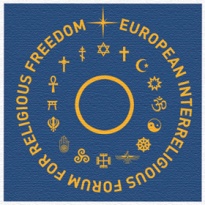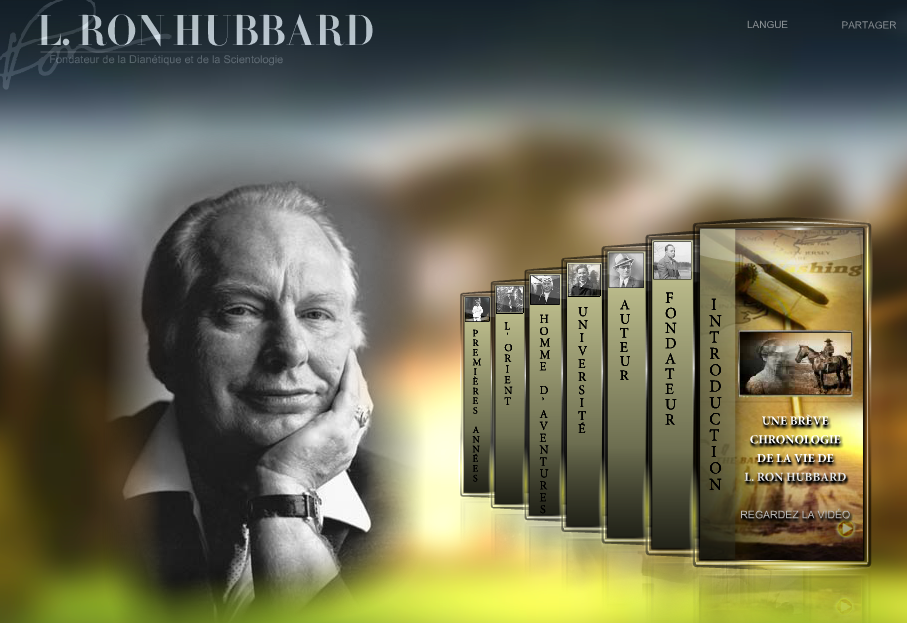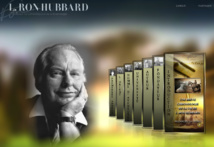Original Source on Orbis.info, in French
It was in 1950 that the American Lafayette Ron Hubbard (1911-1986) published in book form Dianetics, which quickly became a successful bookseller, while drawing criticism from mental health professionals. From the Dianetics approach emerged shortly after Scientology, and by the end of 1953 a first use of the label "Church of Scientology", followed by the gradual establishment of an organization increasingly structured .
Among religious groups, spiritual or quasi-religious emerged in contemporary times, the Church of Scientology is one of the best known. But it is also a movement with which many controversies are associated, even before the debate over "new sects" that took off in the 1970s. It is also a group that escapes the usual classifications of researchers exploring the religious field. This could have earned Scientology specific attention from the researchers: that's not the case. Some academic literature however have emerged in recent years and, probably for the first time, a symposium devoted exclusively to Scientology was held on 24 and 25 January 2014 in Belgium.
As James R. Lewis (University of Tromsø, Norway) recalls in a recent report of an academic monograph on Scientology (Religion, 44/1, January 2014, p. 166-169), this movement has long had the reputation of reacting aggressively not only to criticism, but also to research about them, if they could not control the outcome: the experts keep in mind the serious problems faced by Roy Wallis (1945-1990) in his pioneering sociological research, The Road of Total Freedom: A Sociological Analysis of Scientology (London, Heinemman 1976); Wallis presented and analyzed these issues in two articles ("The moral career of a research project," Salvation and Protest: Studies of Social and Religious Movements, New York, St. Martin's Press, 1979, p. 193-216, "Religious sects and the fear of publicity," New Society, June 7, 1973, p. 545-547). Thereafter, Scientologists have adopted a more positive outlook on this book.
Since the book by Wallis, while critical publications or stories of former members have flourished (a literature that is of interest in itself, but of a different nature), rare was non-controversial research, of sociological or historical type, on Hubbard and the Church of Scientology: Harriet Whitehead’s book, Renunciation and Reformulation:
A Study of Conversion in an American Sect (Ithaca, Cornell University Press, 1987), who took interest in Scientology under the angle of the psychology of conversion, was based on a research conducted fifteen years before (1969 to 1971).
However, Lewis notes, the leaders of the Church of Scientology seem to have changed their attitude in recent years and no longer adopt the same attitude of confrontation against independent researches about their movement. New works begin to emerge: at least half a dozen PhD theses are being written, according to Lewis. As for books, Hugh Urban's one should be mentioned, The Church of Scientology: A History of a New Religion (Princeton University Press, 2011), and the rich collective work edited by Lewis himself, Scientology (Oxford University Press, 2009).
The international symposium at the origin of this article belongs to this emergence of new research on Scientology. Entitled Scientology in a Comparative Perspective, it was organized at the initiative of the European Observatory of Religions and Secularism by Régis Dericquebourg (Lille III University) and hosted by the Faculty for Comparative Religious Studies (FEV) at its headquarters in Wilrijk, a suburb of Antwerp. Program : about twenty interventions presented by figures already known in the world of research, but also by students. I will not try here to summarize the entire conference, which will certainly result in a publication, nor to present submissions in detail, but rather to draw some observations and discuss a selection of a few communications.
Scientology is an interesting example to define religion boundaries, also legally, said Eileen Barker (London School of Economics / INFORM) - a recent decision by a British Court has well illustrated this. Beyond the case of Scientology, the question arises whether we're seeing (or will see) other examples of "rational religion" arise. By the way, let's note that the television commercial aired by the Church of Scientology during retransmissions of the last edition of the Super Bowl, this big American sporting event, focuses on the association between religion and science that they think they offer : "Imagine science and religion connected! Imagine technology and spirituality combined! Now imagine that everything you ever imagined is possible! Scientology: there are higher states of existence." And on the screen, at the end of the message, the letters of the words "spiritual technology" dissolve to form the word "Scientology".
Would Scientology be an invented religion, possibly with purposes having little to do with spirituality ? According to German researcher and protestant theologian Marco Frenschkowski, few people have expressed an interest in the meaning attributed to religion in the works of Hubbard. Frenschkowski focused on this issue and made a more complex statement: he believes that at the start, Hubbard did not intend to launch a religion. In 1954, he explained that the emerging Scientology was not a religion. In fact, Scientology did not become immediately a religion. As for some other contemporary groups, the position regarding the status of religion has fluctuated. According to Frenschkowski, Hubbard, without personal religious background, did eventually realize that what he was doing was a religion.
The potential patronage of Hubbard was not particularly attracted by the image of a religious group. Although Hubbard had initially a rather negative perception of atheism, he presented Dianetics as devoid of religious prejudice. It was only subsequently that Hubbard introduced a religious vocabulary: but Christianity could be not be used as the reference model. Hubbard thus sought other possible models and thought, at first, that Buddhism might be appropriate; but he made this choice without really understanding the foundations of Buddhism. Hubbard had not done many readings on religions. He realized, subsequently, that Scientology could not be developed on the line of Buddhism.
On a practical level, a minority of Scientologists maintain links with other religions; but most have no more. When asked about their concept of God, their concepts are fairly vague, notes Frenschkowski, and in any case, it is not a personal God.
Frenschkowski sweeps the theses of some authors that Scientology would be closer to some aspects of the magical approach, while recognizing that Hubbard was fascinated by magic. For my part, I am less categorical on this point and I remain open to the possibility of an interpretation of Scientology as 'technological magic' – an explanatory line which is not exclusive of other interpretative schemes (for example, analogies exist between a Scientological scenario and Gnostic approaches). In his intervention, J. Gordon Melton (Baylor University) has stressed that Scientology is a revitalization movement of the Western esoteric tradition (that he distinguishes from esoteric circles): according to him, by placing it in this context, and not trying to compare it to Judaism or Christianity, we can understand the Scientological phenomenon.
Scientology in any case is certainly not a religion based on the principles of belief or faith, found Donald Westbrook (Claremont Graduate University) in questioning dozens of Scientologists on their religious experience. Hubbard is not a divine figure for them: he is indeed the one who developed and systematized the Scientology “technology”, but any Scientologist is supposed to be able to reach the same level in principle.
An interesting aspect, noted by several observers in recent years and quoted by Westbrook, but not yet studied, is the interest for Dianetics in the ranks of the "Black Muslims" of the Nation of Islam (NOI), with the approval and encouragements of the leader of this organization, Louis Farrakhan (born in 1933). More than 600 members of the NOI would already have been trained as ‘auditors’.
A stimulating and original intervention by Mikael Rothstein (University of Southern Denmark) dealt with "the physical environment in the Scientological imagination", dealing with the existence in the movement of a sacred topography entirely based on its own references. In Scientology, says Rothstein, everything is linked to L. Ron Hubbard ("the Source") and to his mythologisation. Places related to different stages of the Founder’s life became heritage sites, carefully preserved by the movement. In churches of Scientology, there is an office of L. Ron Hubbard, that seems ready to welcome him at any moment: this room, Scientologists explain, “honors the founder and symbolizes that this Church is faithful to his writings and to his ideals”. But Rothstein analysis goes further: the fact that one continues to provide such a space in every church of Scientology, years after Hubbard's death, shows how Hubbard is embodied : the Scientology organization becomes a kind of presence of Hubbard in the physical world. Buildings become the manifestation of the Organization and its founder - and it should be noted that there has been an intense activity of construction or transformation of existing buildings by the movement in recent years (with the issue, debated, of to what extent this estate effort entails a growth in the concerned regions).
But, in the reincarnationist perspective of Scientology, could Hubbard return in a new body and claim his place in the Organization, questions Rothstein? While nothing would oppose it dogmatically, the answer is however negative: the routinization of Hubbard’s charisma in the organization of Scientology is such that a comeback would be contrary to its interests. The status of the organization is linked to its ‘embodiment’ of Hubbard and, conversely, an hypothetical comeback of Hubbard would mean the ‘excarnation' of the organization, so to speak, as per the provocative interpretation of Rothstein.
What do Scientologists think of it ? One of them was present in the room and explained that Scientologists do not expect Hubbard’s return because they consider Scientology as a full, complete work : nothing else would be necessary to reach "total freedom." Hubbard’s coming back would therefore meet no need.
Some interventions have sketched a subject on which we can only hope for more elaborate studies: the profile of Scientologists. Inga B. Tollefsen (University of Tromsø) observed the male predominance in the audience of the Church of Scientology, in contrast with the female over representation observed in the majority of religious movements. It is not without interest, in regard to the nature and origins of Scientology, to note that the public of science-fiction offers another male over-representation. This leads Tollefsen to wonder if this does not give us an indication of some subcultures more likely to provide converts to Scientology. Would Scientology be a geek-friendly religion? The track deserves to be followed and is waiting to be documented by other research.
A few other items on the profile of the Scientologists have been offered by a communication by Andras Mate-Toth and Gábor Daniel Nagy (University of Szeged, Hungary), as part of a comparative research in Hungary and Germany. According to the results of their survey, the average age of active Scientologists would be about 50 in Germany and a little less than 40 in Hungary, where the movement set foot later; in Germany, the majority of the members who answered the survey entered in the movement in the 1980s, while the majority of their Hungarian co-religionists joined it in the 1990s.
Scientology has had its lot of dissent, as a result of disappointed Scientologists or purges within the organization: some have tried to pursue a Scientological career based on Hubbard’s teachings, but separate from the organization. Many of them did not last, but new independent Scientologists groups arise: one of the most recent cases is the Center Dror in Israel, which announced in 2012 that it was leaving the Church of Scientology to continue on an independent path.
In one case, mentioned by Kjersti Hellesoy (University of Tromsø), the group claims to be the authentic heir of the original organization according to the will of Hubbard: it's the Ron's Org, founded by Bill Robertson (aka 'Captain Bill', 1936-1991). Its members believe that Hubbard died years before the official date and that hostile forces have taken control of Scientology from inside to destroy it. The Ron's Org has introduced various changes in the levels of Scientology, while arguing that those changes are based on Hubbard’s instructions. The insistence on the person of the founder is less great in their centers: there is no photography or bust there, no celebration of the founder’s birthday.
As Hellesoy has pointed out, it is difficult for a scientologist to leave the Church while remaining in Scientology : the 'technology' and the Organization are closely linked. I would add that several factors also contributed to the dissolution of dissident groups: often quite weak structures (dissidents left a rigid organization and did not want to replicate the same model), the attacks by Scientology against independent uses of techniques or materials of which they hold the rights, but also the inclination of a number of dissidents to be interested in other techniques or practices over time.
For researchers, said Melton, one of the difficulties is to simultaneously have access to scientologists and ex-members who denounce Scientology, because of the hostility that exists between the two sides. On the other hand, viewed from different angles, research has become easier, noted the same researcher: at the time of the Internet, for example, not much can remain secret. Important materials on Scientology offers itself to the examination by researchers, and they would do well to collect as much as possible, without neglecting sources such as Scientology publications, suggests Melton, which do not seem to have attracted anybody's special attention until now.
The symposium also was the occasion to hear documented contributions on very specific points, for example by Massimo Introvigne on the curious case of the Brain - Washing Manual published by Hubbard in 1955 (then withdrawn from circulation in 1956), and presented as the synthesis of a supposed secret ‘psychopolitical’ Soviet manual. This publication had been done in the period of fear of Soviet "mind control" in America at the time, and in the wake of the publication of Edward Hunter’s book, Brain-Washing in Red China (1951). The communication by Introvigne, the main elements of which can be found on line as a PDF document, is probably the most accurate analysis of the whole affair, and also clarifies the opinion of Hubbard himself on the question of "brainwashing".
For a long time, said Melton, the controversies surrounding the Church of Scientology have partly dictated the agenda of researchers: it is now time to look at the Scientology phenomenon for itself, and to finally take Scientology seriously as an issue of research, regardless of the opinions one can have about a movement which does not leave indifferent. The very fact that thousands of Scientologists and ex-Scientologists (who remain for some of them interested in the Scientological technology, while rejecting the organization) adhere to Hubbard’s message or to a part of it is in itself sufficient to justify the attention of researchers: the small symposium of Wilrijk might be an indication of a new and necessary step in the treatment of Scientology by researchers who have a vocation to analyze the contemporary visions of the world.









 Interview of Vice-President of EIFRF by the World Forum of Religions
Interview of Vice-President of EIFRF by the World Forum of Religions